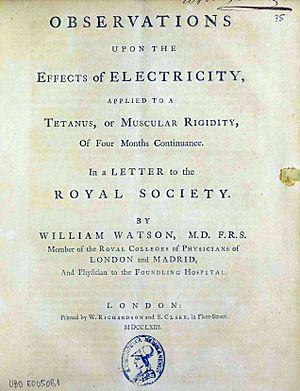William Watson (scientist) facts for kids
Quick facts for kids
William Watson
|
|
|---|---|
 |
|
| Born | 3 April 1715 |
| Died | 10 May 1787 (aged 72) |
| Awards | Copley Medal (1745) |
| Scientific career | |
| Fields | Physician and scientist |
Sir William Watson (born April 3, 1715, died May 10, 1787) was an important British doctor and scientist. He was born and lived his whole life in London. He became a member of the Royal Society in 1741. This is a famous group for scientists. Later, he became its vice president in 1772. He was even made a knight in 1786, which means he got the title "Sir."
Watson first studied botany, which is the study of plants. He helped bring the ideas of Carolus Linnaeus to England. Linnaeus was a famous Swedish scientist who created a way to name and classify living things.
Contents
Understanding Electricity
William Watson made big discoveries about electricity. In 1746, he found a way to make Leyden jars hold more electricity. A Leyden jar was an early device used to store electric charge. He did this by covering the jar inside and out with lead foil.
One Type of Electricity
In the same year, Watson suggested a new idea about electricity. Before him, people thought there were two types of electricity. Watson believed there was only one type of electrical "fluid." He called it electrical ether.
He thought that having too much of this fluid caused a positive charge. Having too little of it caused a negative charge. He also said that the total amount of electricity always stays the same. This is called the conservation of charge.
Watson learned that Benjamin Franklin had the same idea at the same time. Franklin was a famous American scientist and statesman. Watson and Franklin later became good friends. They worked together on science and even on political issues.
Electricity's Nature
Watson also thought that electricity was more like magnetism and light than a fluid. He noticed that electricity could pass through materials like glass and cloth. He also saw that electricity could be focused into a spark. This spark could even light up things that burn easily.
Electricity Experiments
Watson loved to do experiments to understand electricity better. On August 14, 1747, he did a very long experiment. He sent electricity through a wire that was 6,732 feet long. This experiment took place at Shooter's Hill in London.
He did another experiment with an even longer wire, 12,276 feet. Before this, experiments in France had only used much shorter wires. Watson's long-distance experiments showed how far electricity could travel.
See also
 In Spanish: William Watson para niños
In Spanish: William Watson para niños
- The plant genus Watsonia
- The botanical journal Watsonia
Works


